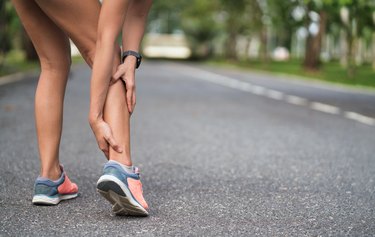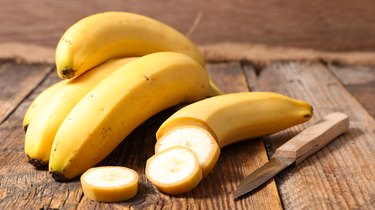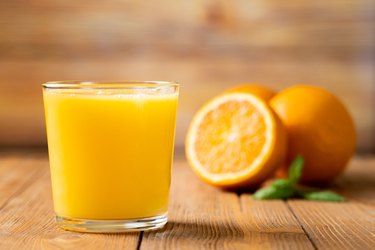
Nothing can make you drop to your knees faster than a charley horse. These sudden and painful cramps are one possible result of low potassium. "Other signs your potassium may be low include fatigue, muscle weakness or spams, tingling or numbness. In more severe cases, you may also experience a skipped heartbeat or palpitations," says Melissa Mitri, RD of Melissa Mitri Nutrition.
You can fight leg cramps and other severe issues associated with low potassium levels by raising the amount of potassium in your body. How long it takes to correct low potassium levels depends on how low they are.
Video of the Day
Video of the Day
Low Potassium Levels
How much potassium you need to take in will depend on how low your levels are. Besides a blood test, it's hard to tell if your potassium is low. That said, there are some symptoms of potassium deficiency to be aware of, according to the Cleveland Clinic. These include:
- Muscle cramps, twitching or severe weakness
- Constipation
- Heart palpatations
- Tingling and numbness
"If your potassium levels are very low, you may need potassium supplements or an IV to be able to quickly get them back up to normal," Mitri says.
The quickest way to raise potassium levels in emergency situations is by IV, which should only be administered in a controlled setting (such as a hospital or inpatient clinic). An IV can start to raise levels within 20 to 30 minutes, per a September 2012 article in the American Journal of Kidney Disease.
"If your potassium levels are just borderline low after a sweaty workout, an electrolyte drink or certain foods can bring them back up fairly quickly," Mitri says. Within 30 to 60 minutes of eating foods high in potassium, small increases can occur in plasma potassium levels, according to an older November 2012 study in the Journal of Athletic Training.
How Much Potassium Do You Need?
"A healthy potassium level is 3.6 to 5.2 millimoles per liter (mmol/L)," explains Mitri. The adequate intake (AI) for potassium for adults assigned male at birth (AMAB) is 3,400 milligrams per day and 2,400 milligrams per day for adults assigned female at birth (AFAB), according to the National Institutes of Health Office of Dietary Supplements (ODS).
People with inflammatory bowel disease and those who take laxatives or diuretics are at a higher risk for potassium deficiency, per the NIH.
Hyperkalemia happens when potassium levels in your blood become too high, which can damage your heart and even cause a heart attack, according to the Cleveland Clinic. People with kidney disease may be at a higher risk of getting too much potassium. Always talk to your doctor before adding high amounts of potassium to your diet.
1. Eat a Banana

Eat a banana or two if you have leg cramps associated with low potassium levels. One medium banana has 422 milligrams of potassium or 9 percent of the daily value (DV). The potassium in bananas can start to increase your potassium levels within 30 to 60 minutes, per the November 2012 Journal of Athletic Training study.
In the study, researchers tested whether eating 1 or 2 bananas would increase potassium levels in adult athletes prone to exercise-induced leg cramps. While there were mild increases in both groups' potassium levels after 30 and 60 minutes, the time it took to increase potassium would not be beneficial to an athlete who cramps up during competition.
The best way to avoid the effects of low potassium would be to eat foods like bananas regularly and also replace lost potassium after exercise.
2. Sip an Electrolyte Drink

Sports drinks can be a great way to replenish vitamins, minerals and water lost through exercise or even periods of vomiting or diarrhea. But, not all electrolyte drinks are high in potassium. The other key nutrients they include are sodium and magnesium, which are also lost when you quickly lose fluids.
Electrolyte drinks are a convenient way to raise your potassium levels, especially if you do endurance training or are sick with the stomach flu. You can sip on a drink throughout a workout to replace fluids and often times it's easier to drink something rather than eat when your stomach is upset. Just remember, that doesn't replace plain water.
The potassium in sports or electrolyte drinks can range from only 50 milligrams to over 600 milligrams, so read the label carefully or choose one of the suggested drinks below.
Which Electrolyte Drink Should You Choose?
- Vita Coco Coconut Water: 646 mg potassium per bottle ($13.76, Amazon)
- Nooma Organic Sports Hydration Mix: 300 mg potassium per packet ($19.99, DrinkNooma)
- Ultima Replenisher Electrolyte Mix: 250 mg potassium per serving ($18.89, Amazon)
3. Snack on Watermelon

One wedge of watermelon (268 grams) has 320 milligrams of potassium, or 7 percent of your DV, making it a great choice to raise your potassium, per the USDA. Watermelon is also an excellent source of vitamin C and vitamin A and is 91 percent water, which is perfect for rehydrating.
Eating watermelon after a workout can help replace water, potassium and magnesium. On top of replenishing hydration, drinking watermelon juice post-workout has been linked to less muscle soreness after 24 hours, per a July 2013 study in the Journal of Agricultural and Food Chemistry. The researchers say this is because watermelon is an excellent source of the amino acid L-Citrulline.
To make a homemade electrolyte drink, blend watermelon with a pinch of table salt to help replace fluids and electrolytes and decrease muscle soreness.
4. Drink a Glass of Orange Juice

Orange juice is an excellent source of potassium, with 496 milligrams or 11 percent of the DV in just one cup, per the USDA. It's also a good source of folate, vitamin C and vitamin A.
Keep in mind that orange juice is a convenient way to raise your potassium, but it can also be high in sugar. Eating an orange is often a better way to get the nutrients from orange juice along with the fiber that will help your body to absorb the sugar more slowly.
But, the potassium in one orange is much less than a cup of OJ. You'd have to eat two oranges to get the same potassium as you would from one cup of orange juice.
5. Take a Potassium Supplement

Potassium supplements can be found in the vitamin aisle at your local pharmacy or online, but you should always check with your doctor before taking them to see if they're right for you. The potassium you eat and what you get from a supplement should not equal more than the recommended amount unless directed by your doctor, per the May0 Clinic.
Too much potassium can cause muscle weakness, an irregular heartbeat, confusion or trouble breathing, per the Mayo Clinic.
Over-the-counter potassium supplements can have 99 milligrams of potassium per serving and are combined with several different substances. You'll find them as potassium chloride, potassium citrate, potassium gluconate, potassium bicarbonate, potassium aspartate and potassium orate, per the Linus Pauling Institute at Oregon State University.
The type you choose should also depend on other electrolyte levels (like chloride or bicarb) in your body. Talk with your doctor about which one may be best for you given the results of your blood work.
Potassium Supplements to Try
- Now Foods Potassium Citrate: ($17.49, Amazon)
- Thorne Potassium Citrate: ($12.35, Amazon)
- Sundown Naturals Multi-Source Potassium: ($7.56, Amazon)
- NIH: "Potassium"
- American Journal of Kidney Disease: "A Physiologic-Based Approach to the Treatment of a Patient With Hypokalemia"
- Journal of Athletic Training: "Plasma Potassium Concentration and Content Changes After Banana Ingestion in Exercised Men"
- USDA: "Banana"
- USDA: "Watermelon"
- Journal of Agricultural and Food Chemistry: "Watermelon Juice: Potential Functional Drink for Sore Muscle Relief in Athletes"
- USDA: "Oranges"
- Mayo Clinic: "Potassium Supplement"
- Linus Pauling Institute at Oregon State University: "Potassium"